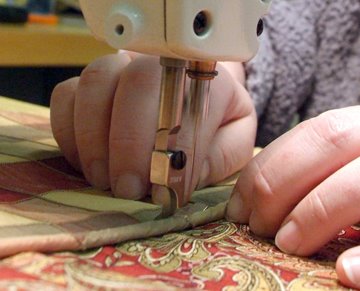 |
| via Traditional Home, left photo: Matthew Benson |
“I grew up in a wonderful household, but a fairly formal one steeped in strict southern traditions – the way that you do things, the way that you set a table, the way napkins are folded. That was where I started and then I cross-pollinated with the dining experiences of living on every continent before I finished high school. There is a lot of cross-cultural pollination in our work and in our habits. Dining is one of those habits that you acquire through life; not only what you serve and what you put on the table but how it’s served and how you perceive those experiences along the way.”
Born in Memphis, Tennessee, Barry Dixon was in the second grade when his father took a job that brought the family around the world. Tennessee and parts of Arkansas are the grounding places that he calls home though and he shared some childhood memories that have influenced the way he lives today. I love to hear the change in tone and inflection when I ask a question that clearly conjures up meaningful and special memories for someone. In Barry’s case, this was definitely when he spoke of his Grandmother Darr, his mother’s mother, and memories of spending time on his grandparents farm. His voice changed, with words coming faster and a bit louder; I could hear him reliving the experience as he narrated. I was telling Barry a bit about my upbringing – and well, the picnic table came up - and that triggered these sweet memories for him.
 |
| via The "Nettie Darr" table [front] is a design in honor of Barry Dixon's Grandmother |
 |
| Garden Dining Area at Barry Dixon's Home via Reminiscient in feeling of sitting under the shade of the pecan trees |
 |
| via Traditional Home An old coffee tin of Barry's Grandmother Darr, inspired one of his fabrics, Cacao Vine, for Vervain |
I remember there was a giant Pecan Grove on the side of the main house of my grandparents farm, there were orchards – it was a sustainable lifestyle, technically – with the animals, the cattle, the fresh eggs, fresh churned butter and all these wonderful things but it was a very Martha Stewart moment when lunchtime came around because she would - with the people that helped her – get right in there, with her sleeves rolled up. It didn’t matter how many people there were; if there were 10 people or 100 people coming in from the fields, she would have prepared it."
 |
| Pecan Grove via MS Design Maven |
There was fried chicken for 100 people, hand pan-fried and creamed potatoes served in blue willow out on those red and white checkered table cloths. There were green beans, cold salads and ambrosia with coconut and mandarin oranges. I can remember there would be an array of desserts and cobblers in long dishes and so people would know what type of cobbler it was – if somebody wanted strawberry rhubarb and someone else wanted plum or peach - my grandmother would cut little fruits and leaves on the lattice top of the three-layer cobblers so people would know before cutting into it. Homemade whipped cream, homemade ice cream, churned right there in the backyard when it was really hot.
I can still see what it looked like; I can still smell it. People nowadays would cater an event like this but not in those days. That was hospitality and that was important! You weren’t inside the house in a formal dining room but what a rich dining experience. The same thing you’d see on the cover of any gourmet magazine now; that is what they served farm hands back in the day.
On the other side of the family, I can remember bells underneath the tables that you stepped on and then service just appeared magically and all that. But on my mother’s side, it was just a different side of that same thing. They were both wonderful and beautiful and steeped in history . They were both hospitable and colored the way I live today, and I live between the two.
Formal guests that you don’t know so well love being treated with a familial essence and yet, you’re most informal, familiar guests – long-term friends and family – love a little bit of thought, formality and consideration put in to their dining experience. If it’s just getting up for coffee and yogurt and granola in the morning, I put everything out. I have flowers. I don’t serve anything in other than a serving dish or some little vessel that is special because they are worth it, they merit consideration; they are the ones you love."
 |
| via |
As I listened to Barry share these special and intimate details of his family life, I couldn’t help but wish we were sitting with a pile of his family photo albums in front of us but through his telling of his story and the pure joy in his voice, a clear picture was formed in my mind. I felt like I was sitting in the Pecan Grove having lunch there too. I hope this journal entry left you feeling the same!
I have so much more on the menu from my conversation with Barry Dixon, but let's savor this and I'll share more with you in the next post! Until then, who else is in the mood for apple cobbler or a slice of pecan pie?























